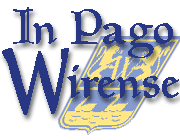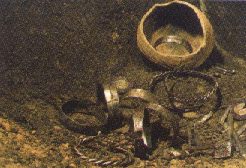

|
| |
 |
the history of Wieringen
|
 | The value of the silver hoard was large, even in those days. The silver would buy you a large farm, with lifestock and serfs. It is hard to make any concrete statements regarding the origin of the treasure. We know quite precisely what the different objects are, but why they were put together in a pot and buried will probably remain a riddle. <-- The replica as can be seen in the local museum |
Kees Nieuwenhuijsen has brought forth an original hypothesis, based on a thesis written by Dirk-Jan Henstra at the Groningen University. At his website he has placed his translation of the Lex Frisionum, one of the oldest codes of law for the Dutch area. He thoroughly discusses the peculiarities of this earlymedieval text that can be seen as a mixture of old Germanic common law and Christian (Caroloingian) civil law.
A large portion of the Lex Frisionum is dedicated to a system of fines that was designed to replace the heathen custom of blood-feud. For every type of crime the Carolingian scholars had calculated a fine which the offender had to pay to the victim or his next of kin. Each fine was based on the value of a person and was defined by a special term: "wergeld". One had to pay one full wergeld as compensation for a killing and a portion of it as compensation for an injury caused by the offender. To give a few examples: putting out an eye of a free man cost 40 shillings, pulling someones hair, without permission ofcourse, had a 4 shillings fine.
The height of the wergeld depended on the societal status of the victim. A nobleman had a higher value than a free man, who in turn was valued higher than a serf. Slaves did not have a wergeld, only a replacement value.
To make a long story short: all through the middle ages the fine for killing a free man changed constantly when calculated in coins, but that was because of several monetary reforms that took place. When the intrinsic value - the weight of the silver - is compared, the wergeld remained surprisingly constant during all these centuries. It was, within a narrow bandwith, 1700 grams. Exactly the weight of the silver hoard at Westerklief. Coincidence? Or not...
We now get on a very speculative course, but suppose that in the ninth century Westerklief a free man was murdered. The matter was resolved according to the local Frisian law (Lex Frisionum), but since it was a turbulent time, the receiving party thought it wiser to hide the wergeld until things calmed down again. And perhaps the murderer was a Danish Viking who served under Rorik, explaining the Danish silver in the hoard? Most likely we will never know for sure...
Musea
The original hoard can now be seen in the Rijksmuseum voor Oudheden in Leiden.
Thanks to grants from the local authorities a replica could be made of the viking hoard. This can be seen in the local museum Huis van de Aarde te Den Oever. The replica shows the treasure as it was found, the original in Leiden lies highly polished on black velvet.